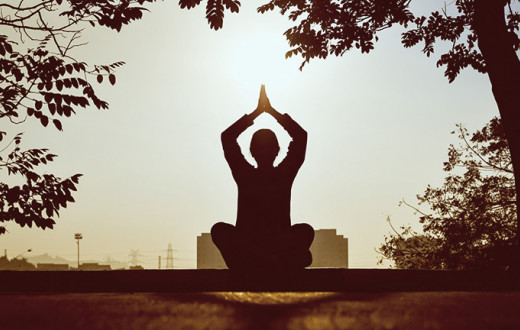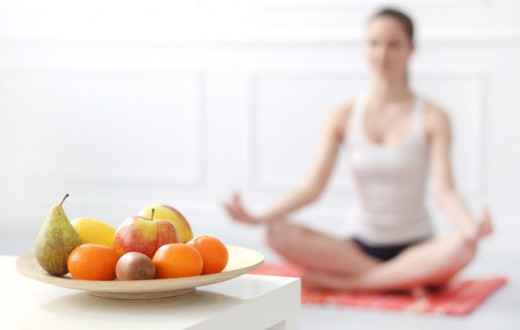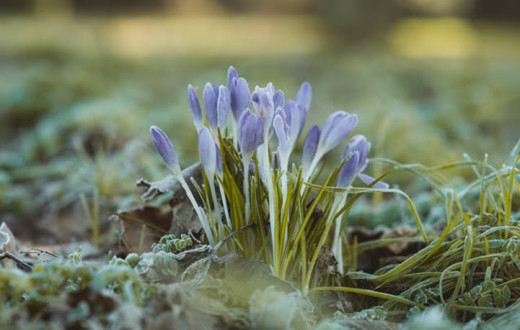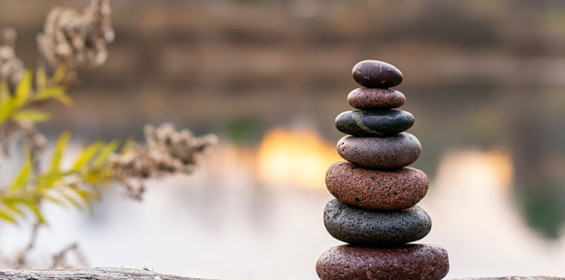By Anuradha Gupta | Posted: April 03, 2020
Do you feel like a hibernating bear emerging after winter? You are not alone. Kapha builds up in winter, liquefies in spring and needs to be cleansed. This time of year there is a possibility of clogging of mind-body channels, congestion, lethargy, skin manifestations, mucus build up, allergies, hay fever, sleep and evacuation disturbances, aching joints, heavy ama (toxins), weight gain, a decline in energy and lowered immunity. Agni (digestive and metabolic fire) declines.
Late winter and spring are Kapha season. Whether we have Kapha Dosha in our Prakriti (body constitution), Vikrati (imbalance) or are influenced by the change in season; we have to be mindful about following a Kapha regimen.
Given the current worldwide health challenges, please use caution utilizing any cleanse regimen, as cleanses can sometimes make you more vulnerable physically. It is strongly encouraged to seek medical advice before starting a lengthy or involved cleanse regimen.
What kind of routine would be strengthening right now? Ayurveda is a science that is in tune with nature and following a seasonal regimen, Ritucharya, comes naturally to us, for instance we dress warmly in winter, and spring ordinarily prompts us to go out and exercise more. Spring is nature’s new year, a cue for us to cleanse clutter from our body, mind and environment, and rejuvenate.
Balancing Kapha Dosha - Kapha is unctuous, cool, heavy, slow, smooth, soft and static. Like increases like and opposites balance. Examples of how to balance this are: exercise and movement; eating light, dry food; staying warm by wearing warm attire, avoiding cold exposure, and having food/liquids that are warm in temperature or potency. Be mindful of your own Vikrati (imbalance)
Spring Diet –Eat regular light nourishing meals; avoid snacking, ensure lunch is the main meal of the day and have an early dinner. Avoid heavy, oily, processed, junk food and too much of sweet, salty, sour, raw or fermented foods. Favor light, warm, easy to digest meals, and bitter, pungent, astringent tastes. Try seasonal fruits, high fiber, well spiced, steamed, baked or grilled veggies, light soups, sprouted legumes, pomegranate, peaches, oranges, berries and apples. Seasonal vegetables like bitter greens, turnips, celery, bitter melon (available at Indian grocery stores), eggplant and cabbage are great; as are grains like barley, corn, quinoa, millet, wheat and basmati rice, plus mung beans and legumes. Use organic honey and jaggery (available at Indian grocery stores) as sweeteners. Have dairy and nuts in moderation. Takra, sometimes called Indian buttermilk, made by adding water to yogurt and churning it, is fine to take during this season. Go easy on oils and fatty food. All spices like holy basil, cardamom, cloves, cinnamon, cumin, ginger, garlic, paprika, coriander, fennel, parsley and turmeric are great.
Sleep - Avoid late nights, get enough sleep and avoid day time sleep which causes build-up of kapha. Make sure to get good rest; it improves our immunity.
Home Cleaning – Nature and our environment is an extension of ourselves. Try cleaning the clutter in the house and spend time doing creative hobbies like gardening which connect you with nature. Doing even a little spring cleaning at a time improves the Vastu, energy, in the house and makes you feel lighter!
Yoga – Build in more exercise and energetic yoga like sun salutations, warrior and triangle pose, Padmasadhana sequence and Yoga Nidra. Your pranayama could be warming like Bhastrika (Bellows breath) and Kapal Bhati , but be mindful of contraindications. Nadi Shodhan (alternate nostril breathing) and full Yogic breathing would be very soothing. Dress warmly to avoid cold exposure if you are able to go outside for cycling or walking.
Meditation – A good way to get rid of lethargy and improve immunity is to meditate. Taking care of the mind is as important as any cleanse, or for that matter any Ayurvedic regimen like Dinacharya. This article is written at a time many of us are struggling with stress and anxiety. Try a guided meditation. Here is a free webinar if you want to learn on how to calm the mind and change your life for good.
7. Cleansing Protocol – Spring is normally the best time for a cleanse in the US, however, since we are going through a pandemic at this time, for some a cleanse could be a challenge. The objective should be to have balanced, regular, nutritious, easy to digest foods, kindle Agni with spices and be mindful with respect to rejuvenating gently, because a cleanse is inherently depleting. Here are 5 reasons to spring cleanse your body and mind every year.
An Ayurveda cleanse differs from other cleanses as referenced in this article on fall cleansing. It is individualized, done under the guidance of an Ayurvedic professional, involves decluttering the mind and lifestyle and most importantly involves a pre-cleanse and a post-cleanse rejuvenation, or Rasayana.
Under normal circumstances, this is how you could do a mild home cleanse using Ayurveda principles:
You could start with a pre-cleanse for 3-4 days, which involves a news media detox and stress reduction protocol with gentle yoga and pranayama. Cut down on processed food and reduce caffeine. Drink warm water with lemon and honey in the morning and sip herbal ginger or CCF tea ( cumin, coriander, fennel) during the day (1 tsp each boiled in six cups of water). Do a light Abhyanga (self-massage) with sesame, olive, dharani, or mustard oil; keep it on for about 20 minutes. Follow it up with steaming (Swedana) which you could even do in the bathroom if tolerated well. Have a warm shower. If your skin is naturally oily, you could do a dry massage, or under the guidance of an Ayurvedic professional, Udvartana, an Ayurvedic powder massage.
During the actual cleanse (for about a week) your diet should be light. In the morning have warm water, lemon and honey; you can add a pinch of cinnamon, sip warm water or herbal tea all day, (you could boil curry leaves in water, cool and drink that). Half hour before lunch or dinner, have ½ tsp Ginger Juice + ½ tsp Honey and a Pinch of Trikatu (a combination of Black Pepper, Long Pepper and Dry Ginger in equal measures). Avoid this if you have Pitta Vikrati (e.g. hyperacidity). You could take a cleansing herb like Ritu Haritaki or Triphala at bedtime.
Note: Take Herbs only as prescribed by your Ayurvedic Practitioner.
During the cleanse the light diet should constitute dry, warm, well-spiced and easy to digest foods. A good example would be a mono diet of khichdi, sometimes spelled kitchari, (a specific lentil/rice combination) with veggies and ghee or any easy to digest traditional food. You could have steamed sprouted moong chaat with lemon and cilantro chutney, or poha (beaten rice) with peas and greens for breakfast, followed by khichdi and steamed veggies for lunch and a dinner consisting of light clear soups and steamed veggies. Sip warm CCF or ginger tea, or tea with warming spices like tulsi, cardamom, cloves, cinnamon or dandelion.
This is followed by a post-cleanse Rasayana or rejuvenation phase for at least a week or more, the most important phase to avoid depletion. Make sure to rest and nourish yourself. Return back to your regular diet slowly; do eat healthy. Avoid heavy, oily, cold, processed, junk food, leftovers, saturated fats, dairy, sugar, soda and alcohol. Rasayana herbs that you could take are Guduchi Rasayana, Adrak Rasayana, Chyawanprash or add ghee and honey to your diet if tolerated well; if you’ve been taking Ritu Haritaki or Triphala, taper it off now. You may find all these Rasayana and herbs online at Sri Sri Tattva.
Following a seasonal regimen helps to build immunity. As we navigate a difficult world situation, turn to your inner resilience for we are together in this; in the words of Dr. Tedros Ghebreyesus, Director-General of the WHO, “We have an opportunity to come together as one humanity; to work together, to learn and grow together.” Coming together is a principle of Kapha which is loving and nurturing and involves a slower pace. Don’t lose heart; this shall pass and that is the kind of hope that spring brings. Stay safe!
If you would like to try Art of Living’s free online guided meditation session and know more about SKY Breath Meditation, join Beyond Breath.
Anuradha Gupta is an Engineer, MBA, writer and Ayurvedic Wellness Practitioner. She has a corporate background and volunteers for Art of Living and other nonprofits. You can find her on Facebook, LinkedIn or Instagram.





























